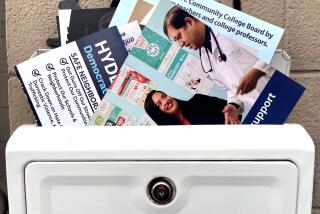‘Spamming’ Spreads Over Computer Networks
It had been a month or more since I’d logged on to one of the online services I subscribe to, and so I was pleasantly surprised to find 15 pieces of e-mail waiting.
Praise and acknowledgments from readers? Messages from some long-lost college buddy?
No such luck. It was all junk e-mail--offers for goods and services I had no intention of purchasing.
More than any other online development, junk e-mail symbolizes for me the downside of the commercialization of the Internet. All kinds of hucksters stand ready to bombard us with electronic hype offering dubious services and shady business opportunities--all of it with no financial risk at all.
The practice of flooding the gates with unsolicited e-mail is called “spamming,” and if you haven’t been spammed yet, odds are that sooner or later you will be.
Offers like these are coming to an e-mailbox near you: the chance to purchase bulk quantities of incense from India, “miracle” herbs guaranteed to melt off pounds, new athlete’s foot treatments, and a kit that will tell you how to make as much as $1,000 a week finding people the federal government owes money to.
Some junk e-mail I’ve seen may not advertise anything illegal, but the pursuits certainly seem to skirt the edges of the law. One advertiser says his scheme isn’t really a chain letter because you enclose a recipe with each letter you send. Of course, you also have to enclose $5 with each letter. If you don’t know enough people, this advertiser will send you the addresses of 5,000 “opportunity seekers” for $260.
Being sent these kinds of offers is maddening. I consider them an invasion of my privacy and a waste of the time I’m forced to spend looking at them--time that could better be spent checking out Web sites or downloading new versions of software. Junk e-mail can also waste my money. If I exceed five hours a month on my online service account, I’m charged for the time beyond that.
*
There’s talk at Microsoft, according to a recent issue of PC Week, of creating an e-mail program that would allow you, the receiver, to charge advertisers for the privilege of dumping messages into your e-mailbox. One way the program might work would be to allow you to tell it to accept only messages from advertisers that pay you, say, at least 25 cents, and to reject any others.
Such a product is years away, however.
More to the point, I don’t believe advertisers will pay us to receive their junk e-mail any more than I believe a sneaker manufacturer will pay me to wear a T-shirt bearing its logo.
For a while, my solution was to copy offending messages, hit the reply button, paste them into my reply as many times as my computer would allow, and send them back.
This low-tech solution was eminently satisfying to me--so much so that I was intrigued when a friend forwarded me a piece of junk e-mail about a program called Spam Slammer. The program was supposed to overload a junk e-mailer’s computers by bombing “the spammer’s e-mailbox with thousands of e-mails of their own message, within minutes.” It was cheap--less than $20--but when I went to find it, the World Wide Web address turned out to be nonexistent.
Of course, there are better ways to deal with junk e-mail. Some mailers allow you to send a reply asking that your name be removed from their lists. And if you keep getting junk e-mail from the same sources, you can set up a filter to reject mail from those addresses if your e-mail program or online service will support it.
If your junk e-mail originates from an address at a service such as CompuServe or America Online, contact that service and let it deal with the sender. (America Online has already opened a battlefront against the biggest junk mailers, shutting off their access to AOL subscribers. The mailers have fired back with a lawsuit, and last week a federal court ordered AOL to stop blocking the access pending the suit’s resolution.)
You’ll have to take care of mail that comes via the Internet yourself.
You might try contacting the “postmaster” at the e-mail address. You can look up the Internet service provider that provides the account in the Internic registry (https://www.internic.net/wp/whois.html). The Internic entry should contain a contact name, address and telephone number.
*
Still, I’m not optimistic that we can do much to stop junk e-mail. There are at least four or five companies that compile lists of e-mail addresses and make them available on the Web. Although their executives say they don’t sell or rent their lists now, they also admit they’re looking into the possibility of doing so in the future.
What seems likely, then, is that we’ll just have to learn to accept junk e-mail in the same way that we’ve learned to scan and discard its real-world paper counterpart.
David Nicholson is an editor of Washington Post Book World. He can be reached at nicholsond@washpost.com






